Introduction
This document describes the Multiprotocol Label Switching (MPLS) based L2 Virtual Private Network (L2VPN) pseudowires.
Background Information
The signalling of the pseudowire and packet analysis in Cisco IOS®, Cisco IOS® XE in order to illustrate the behavior is covered.
Overview of L2VPN
Layer 2 (L2) transport over MPLS and IP already exists for like-to-like attachment circuits, such as Ethernet-to-Ethernet, PPP-to-PPP, High-Level Data Link Control (HDLC), and so on
L2VPNs employ L2 services over MPLS in order to build a topology of point-to-point connections that connect end you sites in a VPN. These L2VPNs provide an alternative to private networks that have been provisioned by means of dedicated leased lines or by means of L2 virtual circuits that employ ATM or Frame Relay. The service provisioned with these L2VPNs is known as Virtual Private Wire Service (VPWS).
- L2VPNs are built with Pseudowire (PW) technology.
- PWs provide a common intermediate format to transport multiple types of network services over a Packet Switched Network (PSN) – a network that forwards packets – IPv4, IPv6, MPLS, Ethernet.
- PW technology provides Like-to-Like transport and also Interworking (IW).
- Frames that are received at the PE router on the AC are encapsulated and sent across the PSW to the remote PE router.
- The egress PE router receives the packet from the PSW and removes their encapsulation.
- The egress PE extracts and forwards the frame to the AC.

Why is L2VPN Needed
- Allows SP to have a single infrastructure for both IP and legacy services.
- Migrate legacy ATM and Frame Relay services to MPLS/IP core without interruption to existing services.
- Provisioning new L2VPN services are incremental (not from scratch) in existing MPLS/IP core.
- Capital and Operational savings of converged IP/MPLS network.
- SP provides new point-2-point or point-2-multi-point services You can have their own routing, QoS policies, security mechanisms, and so on.
MPLS L2 VPN Models
Technology Options
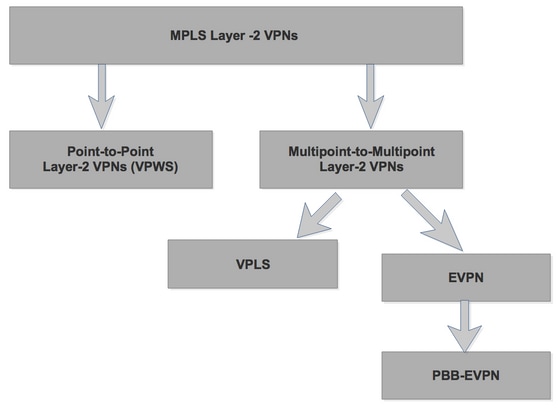
1. VPWS Services
• Point-to-point • Referred to as Pseudowires (PWs)
2. VPLS Services
• Multipoint
3. EVPN
• xEVPN family introduces next generation solutions for Ethernet services
a. BGP control-plane for Ethernet Segment and MAC distribution and learning over MPLS core
b. Same principles and operational experience of IP VPNs
• No use of Pseudowires
a. Uses MP2P tunnels for unicast
b. Multi-destination frame delivery via ingress replication (via MP2P tunnels) or LSM
• Multi-vendor solutions under IETF standardization
4. PBB-EVPN
• Combines scale tools from PBB (for example, MAC-in-MAC) with BGP-based MAC learning from EVPN
EVPN and Provider Backbone Bridging EVPN (PBB-EVPN) are next-generation L2VPN solutions based on BGP control plane for MAC distribution/learning over the core, designed to address these requirements:
- Per-Flow Redundancy and Load Balancing
- Simplified Provisioning and Operation
- Optimal Forwarding
- Fast Convergence
- MAC Address Scalability
VPWS - Pseudo Wire Reference Model
- PW is a connection between two PE devices which connects two ACs, that carry L2 frames.
- Any Transport Over MPLS (AToM) is Cisco’s implementation of VPWS for IP/MPLS networks.
- Attachment Circuit (AC) is the physical or virtual circuit attaching a CE to a PE, can be ATM, Frame Relay, HDLC, PPP and so on.
- You Edge (CE) equipment perceives a PW as an unshared link or circuit.

Layer 2 VPN Enabler: The Pseudowire
L2VPNs are built with Pseudowire (PW) technology.
- PWs provide a common intermediate format to transport multiple types of network services over a Packet Switched Network (PSN) – a network that forwards packets – IPv4, IPv6, MPLS, Ethernet.
- PW technology provides Like-to-Like transport and also Interworking (IW).
- Frames that are received at the PE router on the AC are encapsulated and sent across the PSW to the remote PE router.
- The egress PE router receives the packet from the Pseudowire and removed their encapsulation.
- The egress PE extracts and forwards the frame to the AC.
AToM Architecture
- In AToM network, all the routers in the SP run MPLS and the PE router have an AC towards the CE router.
- In the case of AToM, the PSN tunnel is nothing other than a label switched path LSP between the two PE routers.
- As such the label that is associated with that LSP is called tunnel label in context to the AToM.
- First, the LDP signals hop by hop between the PE.
- Second, the LSP can be an MPLS TE tunnel that the RSVP signals with the extensions needed for TE.
- With this tunnel label, you can identify to which PSN tunnel the carried you frame belongs.
- This tunnel label also gets the frames from the local or ingress PE to the remote or egress PE across the MPLS backbone.
- To multiplex several Pseudowire onto one PSN tunnel the PE router uses another label to identify the Pseudowire.
- This label is called the VC or PW label because it identifies the VC or PW that the frame is multiplexed into.
L2 Transport over MPLS
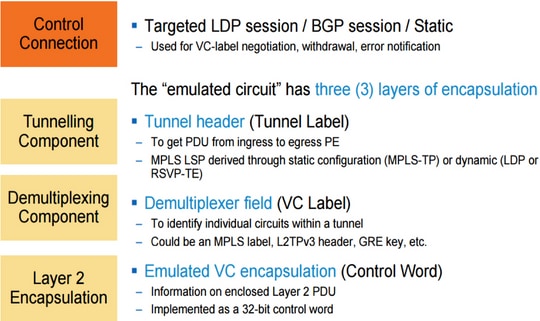
VPWS Traffic Encapsulation

- Three-level encapsulation used.
- Packets switched between PEs using Tunnel label.
- VC label identifies PW.
- VC label signalled between PEs.
- Optional Control Word (CW) carries Layer 2 control bits and enables sequencing.
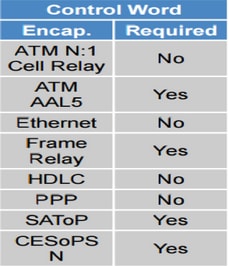
Signalling the Pseudowire
- A TLDP session between the PE router signals the Pseudowire.
- A T-LDP session between the PE routers is to advertise the VC label that is associated with the PSW.
- This label is advertised in a label mapping message that uses the downstream unsolicited label advertisement mode.
- VC label advertised by the egress PE to ingress PE for the AC over the TLDP session. # VC Label by TLDP
- Tunnel label advertised for the egress PE router to the ingress PE by LDP. # Tunnel Label by LDP
Notice that egress PE advertises label 3, which indicated that PHP is used.
The label mapping message that is advertised on the TLDP session contains some TLV:
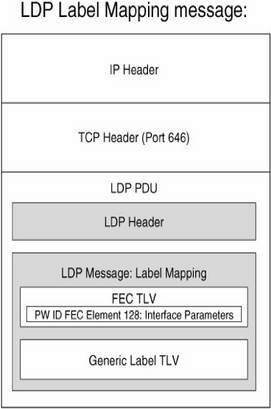
Pseudowire identifier (PW ID) FEC TLV: Identifies the Pseudowire that the label is bound to.
Label TLV < LDP uses to advertised the MPLS label.
The PW ID FEC TLV contains:
1. C-bit: If set to 1 means that the control word is present.
2. PW type: Represent the type of pseudowire.
3. Group ID: Identifies the group of the pseudowire. Same group ID to all AC on the same interface. The PE can use the group ID to withdraw all the VC labels that are associated with that Group ID in one LDP label withdrawal message. This is referred to wildcard label withdrawal.
4. PW ID: PW ID is VC ID
5. Interface Parameters: Identifies the MTU of the interface towards the CE router, requested VLAN ID.
If MTU parameter does not match, then PW does not signal. Because LSP is unidirectional, a PW can be formed only if another LSP exists in the opposite direction between the same pair of PE routers.
The PW ID FEC TLV is used to identify and match the two opp LSP between a pair of PE routers,
Control Word
The control word has these five functions:
- Pad small packets.
- Carry control bits of the layer 2 header of the transported protocol.
- Preserve the sequencing of the transported frames.
- Facilitate the correct load balancing of AToM packet in the MPLS backbone network.
- Facilitate fragmentation and reassembly
- Pad Small packets: If the AToM packet does not meet this min lengthen the frame is padded to meet the min length on the ethernet link.
Because the MPLS header has no length that indicates the length of the frames, the control word holds a length field that indicates the length of the frame.
If the received AToM packet in the egress PE router has a control word with a length that is not 0, the router knows that padding was added and can correctly remove the padding before forwarding the frames.
- Preserved the sequence of the transported frames: With this sequence number receiver can detect the packets:
The first packet sent onto the PW has a sequencenumber of 1 and increments for each subsequent packet by 1 until it reaches 65535
If such out of seq detected they are dropped, re-ordering for out of sequence AToM packet is not done.
Sequencing is disabled by default.
- Load balancing:
Routers perform MPLS payload inspection. Based on that router decides how to LB the traffic.
The router looks at the firstnibble,if the first nibble = 4 then its an IPV4 packet. The generic control word starts with a nibble with vale 0, and the control word used the OAM data starts with value 1.
- Facilitate Fragmentation and Reassembly:
Can be used to indicate payload fragmentation
00 = unfragmented
01 = 1st fragment
10 = last fragment
11 = intermediate fragment
Forwarding Plane Processing
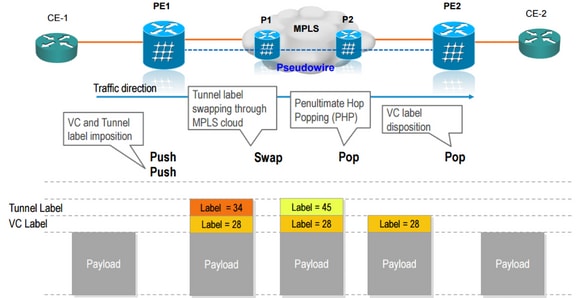
As the ingress PE received the frame from the CE, it forwards the frame across the MPLS backbone to the egress LSR with two labels:
1. Tunnel label (top label) – It tells all LSR and Egress PE to where the Frame must be forwarded.
2. VC label (bottom label)– It identified the egress AC on the egress PE.
In an AToM network, each pair of PE router must run a targeted LDP session between them.
The TLDP session signals chart of the pseudowire and most importantly advertises the VC label.
Operation
Step 1. Ingress PE router first pushes the VC label onto the frame. And then pushes the tunnel label.
Step 2. The tunnel label is the label that is associated with the IGP prefix that identifies the remote PE. The prefix is a specified bit of the configuration AToM.
Step 3. The MPLS packet is then forwarded according to the tunnel label, hop by hop until the packet reaches the egress PE2.
Step 4. When the packet reached to the egress PE the tunnel label has already been removed. This is because of the PHP behavior between the last P router and the egress PE.
Step 5. The egress PE then looks up the VC label in the forwarding information base strip off the VC label, and forwards the frame onto the correct AC.
Signalling the Status of PW
After PE routers have set up the pseudowire, the PE can signal the Pseudowire status to the remote PE. There are two methods:
- Label withdrawal (older of 2)
- A PE router can withdraw the label mapping either by sending the Label withdrawal message or by sending the Label mapping release messages.
- If the AC is down, the PE router signals this by sending a Label Withdraw message to the remote PE.
- If a physical interface goes down, the label withdraws message contains the group id to signal all AC of the interface is down.
- PW status TLV
- The PW status TLV uses the LDP label mapping TLV when the pseudowire is singled. This indicates that the PE router wants to use the second method.
- If the other PE router does not support the PW status TLV method, both PE routers revert back to label withdraw method.
- After the pseudowire is singled, the PW status TLV is carried in an LDP notification message. The PW status TLV contains the 32-bit status code field.
Basic AToM configuration
Step 1. Select the encapsulation type.
Step 2. Enable specifying the connect command on the CE facing interface.
xocnnect peer-router-id vcid encapsulation mpls
Peer-router-id: LDP router id for the remote PE router.
VCID: identifier that you assigned to the PW.
Step 3. As soon as xconnect in both the PE routers is configured, the targeted LDP session is established between the PE router.
Pseudowire Packet Analysis
Initiate a Pseudowire ping from Ingress PE to Egress PE.
MPLS Echo Request and Reply packets sent over point-to-point Pseudowire.
Topology

Ping from PE1 to PE2:
R1#ping mpls pseudowire 10.6.6.6 100
Sending 5, 100-byte MPLS Echos to 10.6.6.6,
timeout is 2 seconds, send interval is 0 msec:
Type escape sequence to abort.
!!!!!
Success rate is 100 percent (5/5), round-trip min/avg/max = 48/61/80 ms
Observations made:
1. ECHO Request:
Carries 2 Labels - VPN and Transport
Sent as Labeled Packet that carry PW LABEL. This can be label switched (with Transport Label).
LABELS : 2
SRC IP : LOOPBACK IP (USED IN TARGETED LDP NEIGHBORSHIP)
DST IP : 127.0.0.1
L4 TYPE : UDP
SRC PORT : 3503
DST PORT : 3505
TOS BYTE : OFF
MPLS EXP : OFF
DF BIT : ON
IPv4 OPTIONS Field is in USE: ROUTER ALERT OPTIONS FIELD ( Punt to CPU)
UDP PAYLOAD can be MPLS LABEL SWITCHING ECHO REQUEST
Overview:

Layer 2/Labels:
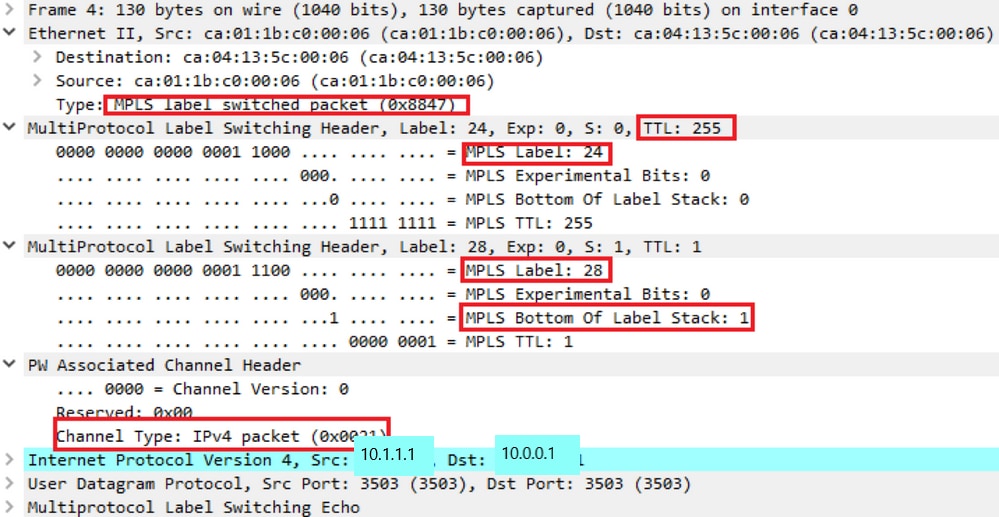
L3/L4:
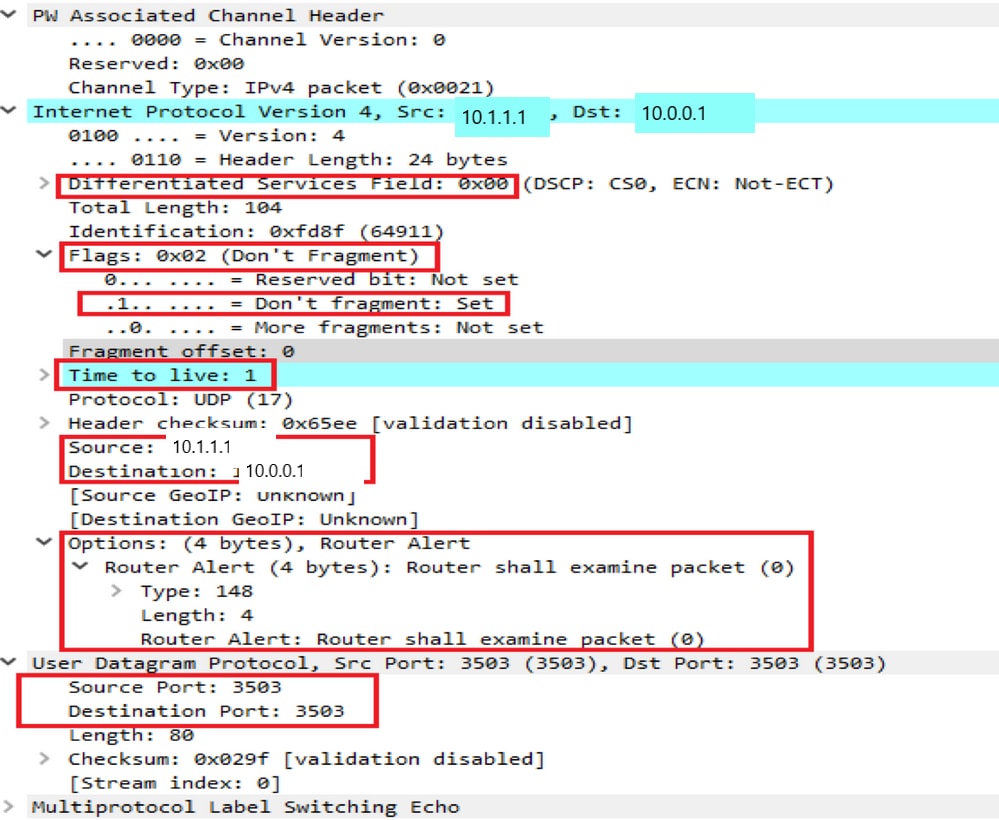
The actual MPLS payload:
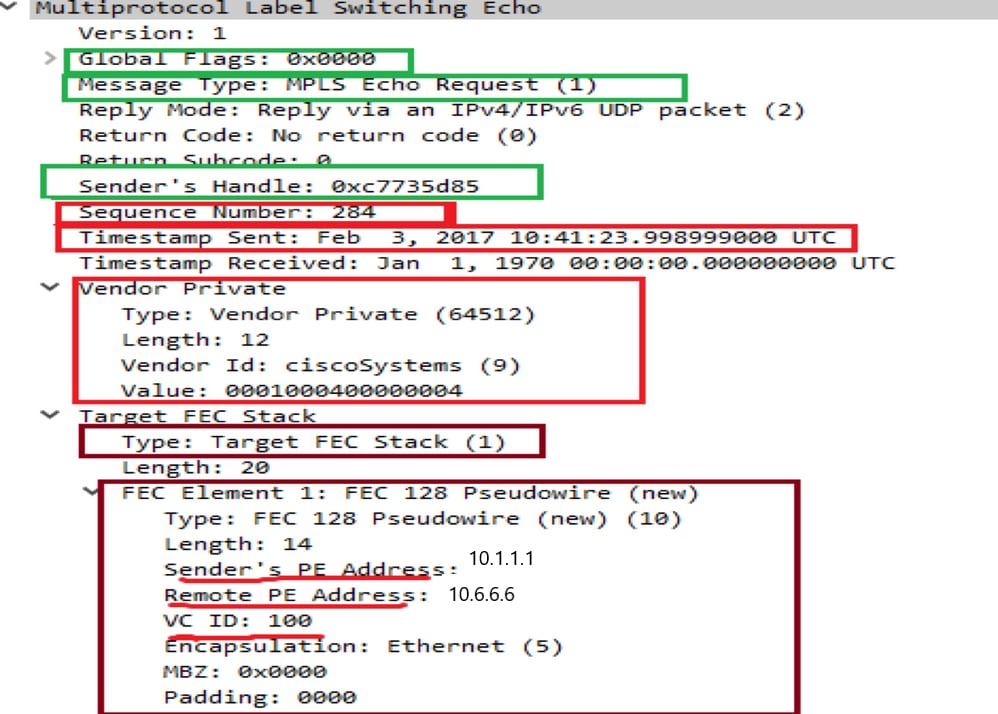
2. Echo Reply:
Can carry 1 Label – Transport.
Sent as UNICAST PACKET. This can be label switched (with Transport Label) because of LDP in a core.
LABELS:1
SRC IP: EXIT INTERFACE IP ADDRESS (10.1.6.2 in our case)
DST IP: SOURCE IP SEEN IN ECHO REQUEST - LOOPBACK OF SOURCE ROUTER
L4 TYPE: UDP
SRC PORT:3503
DST PORT:3505
TOS BYTE: OFF
MPLS EXP: OFF
DF BIT: ON
UDP PAYLOAD can be MPLS LABEL SWITCHING ECHO REPLY
MPLS EXP is ON and SET to 6
DF BIT is ON
VC details for reference:
R1#sh mpls l2transport vc detail
Local interface: Fa2/0 up, line protocol up, Ethernet up
Destination address: 10.6.6.6, VC ID: 100, VC status: up
Output interface: Fa0/1, imposed label stack {24 28}
Preferred path: not configured
Default path: active
Next hop: 10.1.1.2
Create time: 2d17h, last status change time: 2d17h
Last label FSM state change time: 2d17h
Signaling protocol: LDP, peer 10.6.6.6:0 up
Targeted Hello: 10.1.1.1(LDP Id) -> 10.6.6.6, LDP is UP
Status TLV support (local/remote) : enabled/supported
LDP route watch : enabled
Label/status state machine : established, LruRru
Last local dataplane status rcvd: No fault
Last BFD dataplane status rcvd: Not sent
Last BFD peer monitor status rcvd: No fault
Last local AC circuit status rcvd: No fault
Last local AC circuit status sent: No fault
Last local PW i/f circ status rcvd: No fault
Last local LDP TLV status sent: No fault
Last remote LDP TLV status rcvd: No fault
Last remote LDP ADJ status rcvd: No fault
MPLS VC labels: local 28, remote 28
Group ID: local 0, remote 0
MTU: local 1500, remote 1500
Remote interface description:
Sequencing: receive enabled, send enabled
Sequencing resync disabled
Control Word: On (configured: autosense)
Dataplane:
SSM segment/switch IDs: 4097/4096 (used), PWID: 1
VC statistics:
transit packet totals: receive 1027360, send 1027358
transit byte totals: receive 121032028, send 147740215
transit packet drops: receive 0, seq error 0, send 0
L2VPN Interworking
L2VPN Interworking builds on this functionality by allowing disparate attachment circuits to be connected. An interworking function facilitates the translation between different Layer 2 encapsulations. In earlier releases, the Cisco series router supported only bridged interworking, which is also known as Ethernet interworking.
Up to this point in this, the AC on both the sides has been the same encapsulation type, which is also referred to as like-to-like functionality.
L2VPN interworking is AToM feature allows different encapsulation type at both sides of the AToM network
- It is required to interconnect two heterogeneous attachment circuits (ACs).
- The two main L2VPN interworking (IW) functions supported in Cisco IOS Software are:
1. IP/Routed:MAC header is removed (and replaced with MPLS labels) at one end of the MPLS cloud and a new MAC header is constructed at the other PE. The IP header is retained as it is.
2. Ethernet/Bridged: MAC header is not removed at all. The MPLS labels are imposed on top of the MAC header and the MAC header is delivered as is to the other end of the MPLS cloud.
Interworking Possibilities
a. FR to Ethernet
b. FR to PPP
c. FR to ATM
d. Ethernet to VLAN
e. Ethernet to PPP
Related Information














 Feedback
Feedback